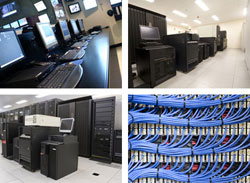8 ways to save energy for a data center
Companies need not build an entire new data center to start saving energy. Here are some effective steps provided to us by Burton Group analyst Andrew Kutz, who can follow these steps for their existing data centers to save the waste of energy.
1. Cut down on the number of physical servers through high-density options like 'blade' servers and through virtualization.
2. Reduce storage hardware by using SANs or other NAS devices to consolidate storage space. The consolidation of physical blocks significantly affects the amount of energy consumed by the data center and also reduces the cost.
3. Consider energy-efficient hardware like multi-core CPUs to reduce unnecessary redundancy and electrical power to supply these redundant components.
 4. Examine the step-by-step technology for CPU execution to be able to explicitly adjust the power required by microprocessors during load.
4. Examine the step-by-step technology for CPU execution to be able to explicitly adjust the power required by microprocessors during load.
5. Dynamic control of the fans inside the server can also reduce the energy needed when the air in the data center is cool enough.
6. Liquid cooling for server rows can limit the amount of energy needed to reduce the heat of the data center.
7. Create a side-wing corridor and rows to arrange equipment in the center properly. Although this technique was invented in the mid-1990s, it was still very effective.
The design of air conditioners can blow through the wings and slots of the server ranges. Lead hot air from the back of the server to the pipes leading to the outside, thus reducing energy for cooling.
8. Search for multi-threaded software to take advantage of computers with multi-core processors. 'Today you can buy a new server with installed feature software that supports multi-core, but most software has not yet been written for it, so you can't benefit. Using the advantages of this new technology, 'Kutz said. The problem here is that software design professionals need to make sure their software can take full advantage of the strengths of these computers.
Van Linh
- Video: The world's largest green data center in the Arctic Circle
- Facebook builds a huge data center in Ireland
- Why did Google choose to build a data center in Singapore and Taiwan?
- Discover 10 unique data centers in the world
- 5 ways to safely backup data
- What is inside Google data center?
- 7 steps for a green data center
- Visit Facebook's data center, where the app tests over 2,000 phones at the same time
- Six ways to prevent data leakage
- Unexpected energy sources for the future
- Huge data center of Facebook in the Arctic Circle
- US established a 200 million USD scientific data center
 What is the Snapdragon SiP chip?
What is the Snapdragon SiP chip? How to create a yellow circle around the mouse cursor on Windows
How to create a yellow circle around the mouse cursor on Windows Edit the Boot.ini file in Windows XP
Edit the Boot.ini file in Windows XP 3 ways to restart the remote computer via the Internet
3 ways to restart the remote computer via the Internet Simulating Einstein's formula, scientists prove that light can create matter
Simulating Einstein's formula, scientists prove that light can create matter  First hydrogen-powered gas turbine tested
First hydrogen-powered gas turbine tested  Does antimatter really exist?
Does antimatter really exist?  20 telescopes dazzled by 'cosmic monster' that transcends time by 8.5 billion years
20 telescopes dazzled by 'cosmic monster' that transcends time by 8.5 billion years  Why can migratory birds fly thousands of kilometers without eating?
Why can migratory birds fly thousands of kilometers without eating?  Discover the world's first reactor that can produce endless energy
Discover the world's first reactor that can produce endless energy 